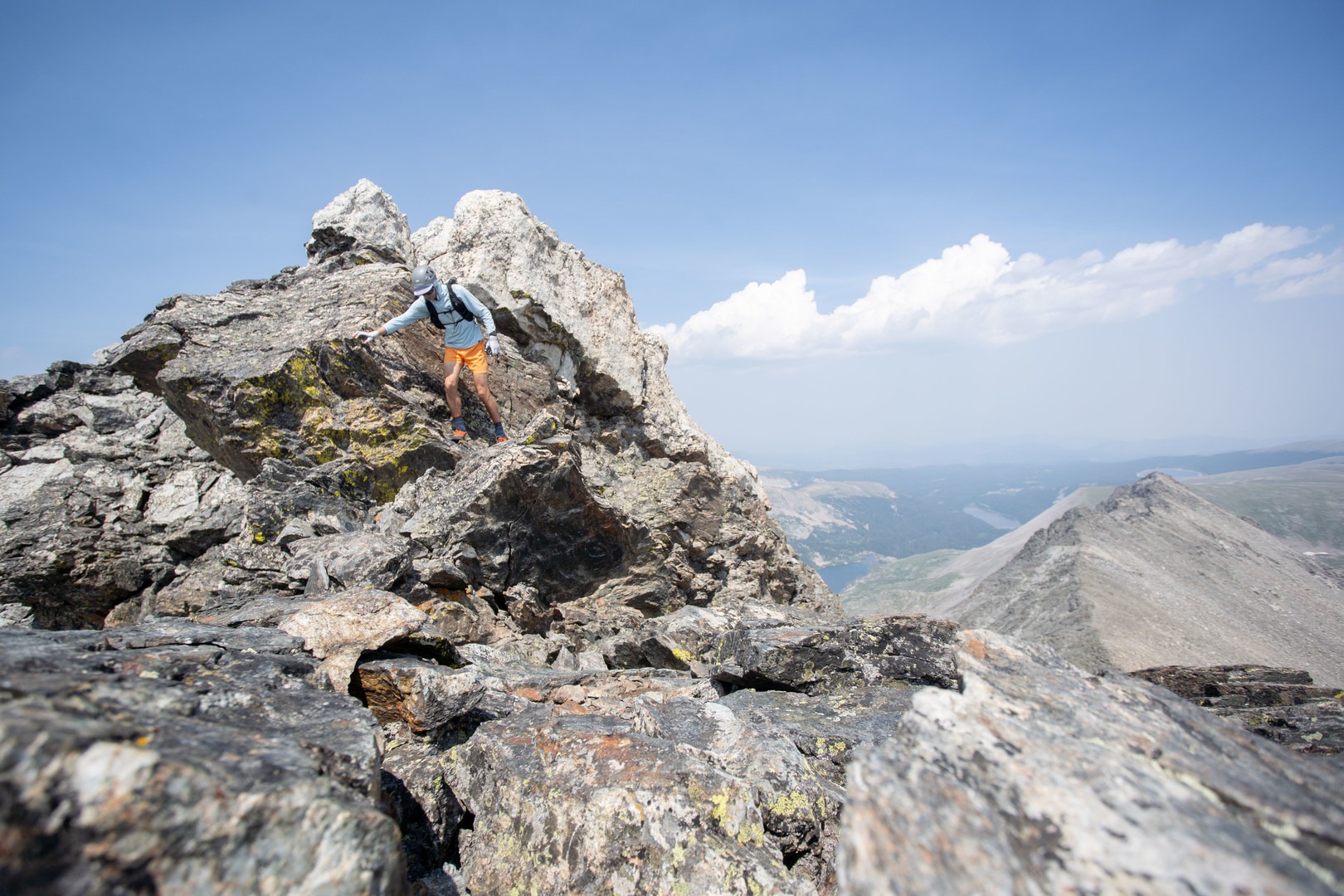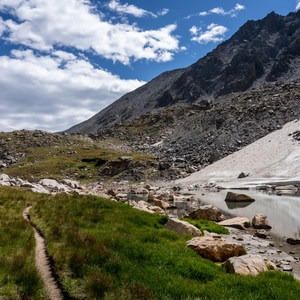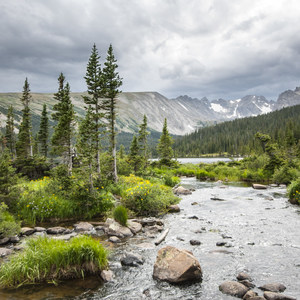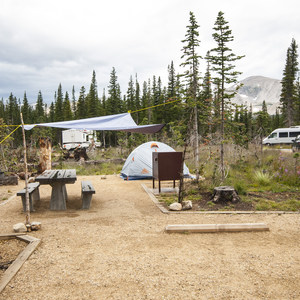You are here
While the 53 (58?) 14ers of Colorado get all the attention, there are almost 600 13ers, and generally, the CO 13ers are more rugged, less traveled, and end up feeling more adventurous, even when they’re right in the Front Range.
If you’ve cut your teeth on more commonly traveled scrambling routes and are looking to spice things up, doing Apache or Navajo as a standalone trip is a great choice. And if you’re comfortable on exposed third and fourth-class terrain, consider traversing between the two.
The route on Navajo also contains a tragic piece of history: in January 1948, a plane crashed into the side of Navajo Peak, killing all three occupants, likely due to a severe downdraft. The shattered plane remains in the now-named “Airplane Gully”, and if you attempt the route, you’ll pass by it. When you do, be respectful.
A disclaimer on this description and track - this off-trail line was traveled on a single day with certain conditions. The route described is a reasonable way to move through this terrain, and the description below mentions some of the hazards found during the trip. However, conditions may be significantly different when you visit this area. The advice in this trip report is not meant to be followed perfectly - you will need to adapt the route for the conditions you find and for your party’s abilities.
The Basics
-
Seasonality/Snow: This route will generally be dry from mid-July to September.
-
Route Options:
-
Apache and Navajo can both be climbed by a variety of different routes depending on your skillset and the snowpack.
-
This report will describe Apache Peak via the East Ledges and Navajo via the Airplane Gully, traversing the ridgeline between the two (ascending the West Chimney of Navajo.
-
Apache Peak can also be climbed via Queens Way (a couloir requiring snow), Fair Glacier, and the burly Kasparov Traverse.
-
Navajo Peak can also be climbed via the Navajo Snowfield and Niwot Ridge.
-
-
-
Number of Days: This goes in a single day, though you can get a permit to camp in the wilderness if you want to make a longer trip out of it.
-
Navigation: Bring a map and/or a GPS, it can get a bit tricky out there.
-
Gear:
-
Good gear for scrambling and moving fast in the mountains.
-
Warning, there’s a ton of loose rock on this route. Bring a helmet.
-
You’ll want an ice axe and traction (microspikes/crampons) if it’s still early season.
-
Permitting
-
As of 2021, cars driving into the Brainard Lake Recreation Area require an access permit from June to October (due to heavy use). As of 2022, permits can be purchased here, and as of 2022, if you don’t get a permit, you can park at the Brainard Gateway Trailhead and hike or bike to the Long Lake trailhead. This adds 7 miles and 500’ of gain if you choose to hike the additional difference.
A Note on LNT
This is a popular area (as proven by the permitting system). If you’re traveling off-trail and summiting peaks like this, you know the drill, but it bears repeating. Please make sure that you're modeling proper Leave No Trace behavior for your partners and other backcountry folk. Clean up after yourself and others to ensure that this special area stays the way it is for future visitors!
The Trip
From Brainard Gateway to Long Lake Trailhead
If you didn’t get a permit, it’s not a big deal, and the lower hike is quiet and pleasant. From the Gateway trailhead, head north of the road and get on the Waldrop Trail. Follow it to the South St Vrain Trail, hang a left and meander between different trailheads to the Long Lake Trailhead. With a GPS or map, it’s easy. Without, you might get turned around.
The Approach (from Long Lake to the 12,100' alpine basin)
Follow the Pawnee Pass Trail west up the valley alongside South Saint Vrain Creek. You’ll pass by Long Lake almost immediately before gaining elevation up to the beautiful Lake Isabelle. Take a left at the Pawnee Pass turn and continue alongside Lake Isabelle as you climb into the alpine. After 3.6 miles (from the Long Lake trailhead) you’ll reach a small tarn. At the tarn, the established trail turns right and accesses the Isabelle Glacier, but you’ll head west southwest off trail. Cross the South Saint Vrain Creek and climb up steeper terrain into a basin at 12,100’.
Climbing Apache Peak
From the basin, head toward Decker’s Peck (the tower between Navajo and Apache) and the snowfield beneath it before getting onto the low-angle slabs. Begin climbing the second/third class East Ledges of Apache Peak, heading northwest up ledges and talus. Once the ledges end, continue up the broken terrain, trending northwest to the low-angle ridge south of Apache Peak. From there, the summit is only a few steps away.
On the summit, enjoy the views north to Longs Peak and take in the burly fifth-class Kasparov Traverse (which connects Apache to Shoshoni Peak).
Traversing to Navajo Peak
Head south from Apache Peak, following the obvious ridgeline. You’ll pass over a knob, descending steeper third-class terrain toward Decker’s Peck, an obvious tower just northeast of Navajo. Pass Decker’s Peck on the north side of the ridge.
Here, you’ll begin getting into serious 4th class terrain. Head southwest up a third-class ramp. From here, you’ll see the west chimney - the northernmost gully on the west face. This chimney contains at least one 4th class move. Once you’re up, trend climber’s right and get to the south ridge. Scramble up the ridge to the summit!
Descending off Navajo
Downclimb the south ridge till you can descend east. Follow the broad ridge east, being sure not to trend too far south (south of this ridge is owned by the Boulder Watershed and closed to the public). Travel roughly a quarter-mile east before dropping north into the tight gully. This is Airplane Gully. Don’t drop too soon or you’ll get into burlier downclimbing.
Airplane Gully is remarkably loose, so be careful about descending above or below other parties. You’ll pass the main wreckage of the airplane at 12,800’. Continue back to the 12,100’ basin.
Back to the car
From the 12,100’ basin, head back down to the tarn, hop back on the trail and cruise back to your car. Make sure you keep looking upvalley and you’ll see the peaks you just climbed growing further and further away. Take a dip in Lake Isabelle before finishing!
Logistics + Planning
Current Weather: Powered by Dark Sky






























Comments
Sign In and share them.